During BIP Wealth’s recent Quarterly Market Webinar, Eric Cramer, CFP®, CFA®, BIP Wealth’s Chief Investment Officer shared a timely and insightful update that focused less on artificial intelligence this time—and more on what’s truly shaping today’s economic environment. The session was divided into three parts: a strategic review of BIP Wealth’s 2025 market themes, a recap of Q1’s market behavior, and a look forward at the implications of reemerging global tariffs.
In case you missed the presentation, we’ll go over Eric’s main talking points. You can also watch the recording of the presentation..
Below is a breakdown of the key themes covered and how they apply to investors.
Eric shared that investors must reconsider their approach to risk in 2025. The first quarter highlighted vulnerabilities in public markets, especially within tech-heavy portfolios. While some investors remain heavily tilted toward growth stocks, Eric emphasized the importance of rebalancing portfolios to include more resilient, diversified holdings.
Private markets—especially private credit—are a critical part of this evolution. Many investors still have limited exposure to private credit, even though it can offer income stability and reduced correlation to stock market swings.
BIP Wealth has the tools in place to help clients diversify effectively. Beyond asset classes, our message is also about planning discipline: investors should align their portfolios with long-term goals, not short-term trends. Eric cautioned against assuming that more risk automatically means more return, especially when individual plans might already be on track with more moderate exposure.
“Financial plans should guide risk, not the headlines.”
In the next section, Eric covered the notable movements from Q1 2025. The standout theme? Technology stocks saw significant declines, disrupting the market’s previous growth-led narrative. Simultaneously, the U.S. dollar experienced a noticeable drop, adding complexity to global investments.
The volatility seen in early April raised concerns, but a rebound later in the month provided perspective. Despite dramatic swings, the market returned to roughly where it started by the end of April. This whipsaw behavior reinforced why tactical shifts alone aren’t sufficient: portfolios need long-term resilience, not just short-term reaction.
For active observers, this served as a reminder that recovery often follows volatility—but only disciplined, diversified portfolios benefit consistently over time.
Finally, Eric wrapped up this quarter’s report with a segment dedicated to tariffs. While trade policy developments are complex and far-reaching, here’s an overview of what matters now:
Global economic friction is back, and it needs to be factored into asset allocation decisions. It’s not just about what’s growing—but what’s being taxed, restricted, or redirected.
Eric closed by encouraging every client to revisit their financial plan. Too many investors are still positioned based on outdated assumptions—chasing growth or risk without considering whether it’s necessary for their goals.
Drawing comparisons to pre-2008 planning errors, the team warned against overreaching. Many clients could meet their objectives with lower risk—provided they embrace more balanced, well-structured portfolios that incorporate alternatives and downside protection.
“You don’t need to ride the roller coaster if your goals don’t require it.”
This quarter’s report made one thing clear: in a year of shifting risks—tech pullbacks, currency changes, and geopolitical trade pressures—flexibility and discipline matter more than ever. BIP Wealth continues to evolve its strategies to help clients thrive through the uncertainty.
If you’d like to speak to a Personal Wealth Advisor about your portfolio or want to learn more about how we’re engineered to perform for our clients, be sure to contact us. You can also check out the rest of our resources hub to learn more.
This communication contains general investing information that is not suitable for everyone and is subject to change without notice. Past performance is no guarantee of future results and there is no guarantee that any views and opinions expressed will come to pass. The information contained herein should not be construed as personalized investment advice, tax advice, or financial planning advice, and should not be considered a solicitation to buy or sell any security. Investing in the stock market and the bond market involves gains and losses and may not be suitable for all investors. Indices are not available for direct investment.
If you have been consuming financial news this week, you will know the stock market has taken a bit of a plunge due to the tariffs announced on Wednesday afternoon. This comes on the heels of a volatile stock market in the first quarter. We wanted to give you BIP Wealth’s perspective on these recent events, although we are not ready to predict the final outcome.
We think the best way to understand what’s happening is to consider the actions of the four forces at play:
The current administration is using tariffs to re-write the economic relationship between the United States and other economies. For many years, other countries have imposed tariffs on U.S. goods and services that have been a bit lopsided against us. The U.S. has imposed its own tariffs on some imported goods in an effort to protect workers, while at the same time there have been numerous “free trade” agreements with favored nations. The history of tariffs goes back hundreds of years, but in more recent times the U.S. has emerged through it all as the world’s leading consumer economy of imported goods, while oftentimes struggling to export its own products while struggling with downward wage pressure at home. These newly announced tariffs are a powerful negotiating tool designed to leverage our consumer appetite and economic strength, but it is impossible to know where this will all settle out and when.
China has already announced retaliatory tariffs, although one could argue that the new U.S. tariffs were in retaliation for a massive trade imbalance that China protected. Over the next week we can expect to hear similar announcements from dozens of countries. This progression into a “trade war” could have a significant negative impact on the global economy, however many countries are expected to reach out to the Trump administration to negotiate. Some of these responses will likely be an effort to make the kind of “phenomenal offer” that President Trump has hinted he would be looking for. It is impossible to predict how this will end, but we will be watching to see the terms of the first few deals to see what it takes to settle these issues.
For the past year, the Fed has enjoyed owning what is often called the “Fed Put.” This is borrowing terminology from the options markets, and refers to the idea that if the economy gets in trouble then the Fed can respond by lowering interest rates to prevent a recession. However, this only works when inflation is contained. Generally speaking, when interest rates are lowered it can cause inflation to rise; and with the Fed having bungled this quite a bit in the post-pandemic era they will likely be slow to move. Today President Donald Trump called on the Fed to lower overnight rates immediately. But tariffs on imported goods are expected to double the rate of inflation in 2025 to perhaps a rate of 5%, so any move by the Fed that could make that worse is quite the gamble. The Fed has a mandate to foster full employment, stable long term interest rates, and low inflation; but it does not have a mandate to do exactly what is being asked of it now. It is impossible to know how the Fed will respond at this point, although we will be listening intently to find out.
For the moment, the idea of tariffs seems to enjoy broad support among working Americans. Many families have watched in frustration for decades as furniture, textile, and manufacturing jobs have been offshored. Real wage growth in non-technical jobs has been slow, and it is correct to think that globalization has worsened the economic fortunes for many Americans. At the same time, we have enjoyed the benefits of lower prices on goods manufactured in low labor cost countries in Asia and elsewhere. Wall Street voices have been highly critical of the scope and pace of the new tariff policies this week, but that group is simply not the President’s constituency. If we fall into a recession, and American unemployment spikes, it will likely be happening around the globe even worse.
Understanding the situation through these four forces may not give you any comfort right now. But this is how we see it, and we’re watching events unfold just like you. Let’s keep in mind that a relief rally could be upon us at any time, and it could be a big mistake to assume that the pace of the sell-off will simply continue.
In our Annual Market Report earlier this year we suggested some steps you could take to prepare for this kind of uncertainty. Click the link below to check out Eric Cramer’s Webinar from Q1…
As a reminder, here are our 4 Key Themes for 2025 and what we’ve seen so far:
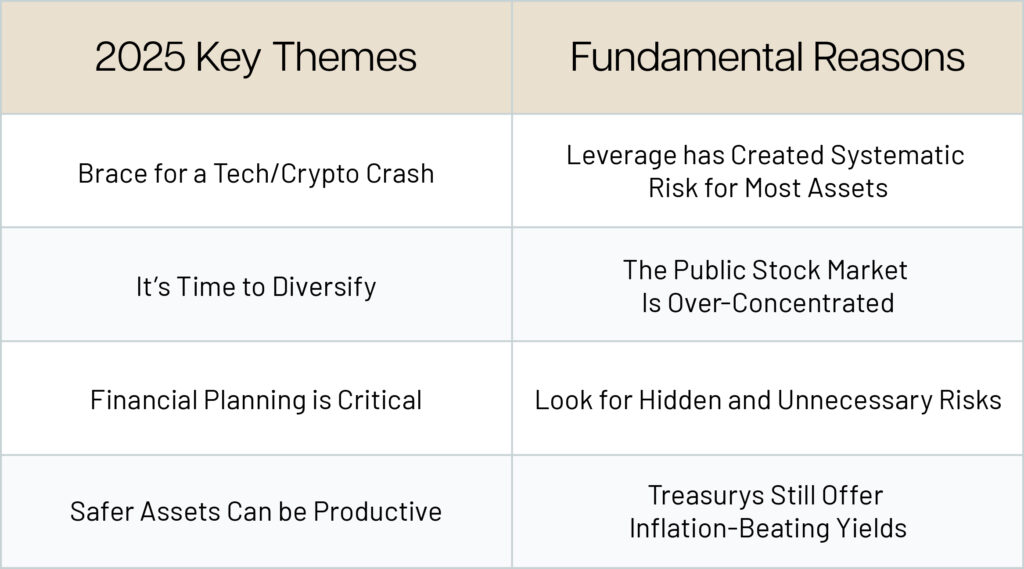
Brace for a Tech/Crypto Crash (Leverage has Created Systematic Risk for Most Assets)
Well, tech stocks did crash. We have strategies in place to help clients with large concentrations to mitigate risk.
It’s Time to Diversify (The Public Stock Market is Over-Concentrated)
We suggested that indexing would not be sufficient due to the concentration in public equities, and that using private credit in particular could be an effective way for many clients to possibly increase their expected return while lowering their expected risk.
Financial Planning is Critical (Look for Hidden and Unnecessary Risk)
We did our best to suggest that some clients may have more exposure to public equities than they “needed” to have. This was in addition to the other benefits of financial planning, such as risk mitigation through an insurance review.
Safer Assets Can be Productive (Treasurys Still Offer Inflation-Beating Yields)
We offer clients BIP Short-Term Tactical, which is our proprietary trading strategy providing an alternative to holding cash in banks. The primary goals of the strategy include achieving a rate of return higher than banks commonly offer, capital preservation, and liquidity, while mitigating risk.
While we can’t predict the future, we strongly suggest having a well-rounded financial plan. This is a great time to take a look at your particular situation and work with a BIP Personal Wealth Advisor so you can take advantage of all the tools we have at our disposal.
Thanks for reading, and please know that we will continue to update you as events unfold.
This post is provided for informational purposes only. Specific investments may not be suitable for all investors and no offer or recommendation of any investment or investing strategy is intended. The opinions in this commentary are as of the posting date and are subject to change. Information has been obtained from third-party sources we consider reliable, but we do not guarantee the facts cited are accurate or complete. This material is not intended to be relied upon as a forecast or investment advice regarding a particular investment or the markets in general, nor is it intended to predict or depict the performance of any investment. We may execute transactions in securities that may not be consistent with what is mentioned here. Investors should consult their financial advisor on the strategy best for them. Past performance is no guarantee of future results. All investments involve risks including loss of principal.
Welcome to our final BIP Wealth Quarterly Market Report of 2024 with Eric Cramer, CFP®, CFA®, Chief Investment Officer. In Q4’s report leading up to the 2024 U.S. Presidential Election, Eric starts with a look at historical trends under each presidential administration dating back to 1926 and touches on other key economic data points.
In case you missed the presentation, we’ll go over Eric’s main talking points below. You can also watch the recording of the presentation below.
With the upcoming 2024 U.S. Presidential Election, we know that a political crisis may test the market. Eric encouraged everyone to take a moment to put on their investor hat. From that more narrow perspective, Eric reviewed the history of the S&P 500 to see how that’s performed over history in the context of who is in the White House. What we see is that markets have gone up over long periods of time under every administration. The point is to remind people that when you’re investing in the stock market, you’re really investing in a much larger system than who is in office at any particular time. You’re investing in democracy, you’re investing in capitalism, you’re investing in the ingenuity and entrepreneurialism of the U.S. in particular. It’s an investment and trust in a system that’s bigger than any one particular candidate.
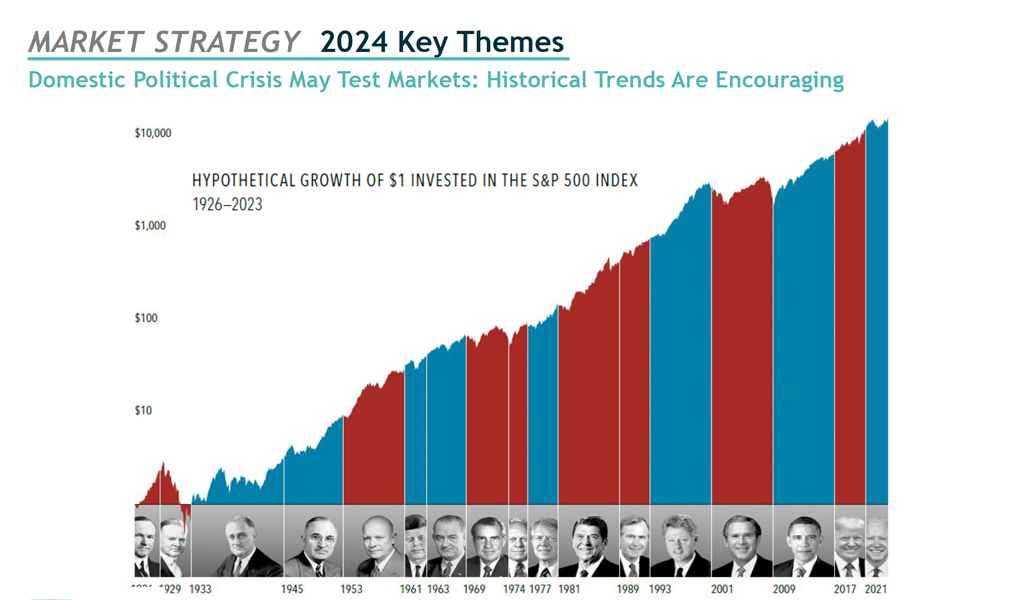
Source: BIP Wealth Quarterly Market Report, Q4 2024
Looking back over the last 90 days of Q3, the Global Equity Index ended higher than when it started, which has been the pattern all year. There were some fluctuations here and there from a variety of events. Two major headlines stood out in interest to Eric when analyzing the market’s overall performance. The first was the UK’s Labor Party winning election, with the Conservative Party being thrown out. Like in the U.S. and around the world, there was inflation in the UK, and the party in power took the blame and got tossed out.
The second headline of particular interest to Eric is that the Federal Reserve cut rates by half a percentage point. While Eric had hoped they’d start cutting rates at the beginning of this year, they’re still catching up. Regardless, we are happy to see a 50 basis point rate cut at the end of the quarter. The market liked that and continues to like that.

Source: BIP Wealth Quarterly Market Report, Q4 2024
Looking at the blended benchmark results, things have continued to evolve since the Fed cut rates. We’re seeing an amazing 5.2% return in the Fixed Income Index for the last 3 months in light of the YTD return being 4.45%.
This is interesting because Interest rates fell across the yield curve. The 3-year return for the Fixed Income Index is -1.39% per year. Now because of the Fed getting out of the way, interest rates have started to rise. We see that as a vote of confidence in the economy. The YTD return as we’re reporting today is less than 2%. More than half of what you see in the YTD return has been wiped out.
It’s a good thing that we do not index our exposure to the fixed income market here at BIP Wealth, instead we’ve been fortunate to take advantage of higher short term rates and have a very stable, predictable return for our clients.
Let’s talk about the future. We’ve been able to be optimistic all year long like we were the year before.
Economic growth has been quite solid. There’s been some interesting updates to prior history that’s come out this quarter. For instance, there was a report that dramatically reduced the number of jobs that have been created in the last 18 months, but just a few days after that, we got an update that revised upwards the 2022 rate of GDP growth and also the 2023 rate of GDP growth.
When we get a GDP number, what we know is that’s not the final number. It will be revised time and time again. Eric’s favorite indicator is the Weekly Economic Index (WEI). It’s a bit more volatile, but over the long run that tends to correlate nicely with the eventual GPD numbers that we’re able to prove valid. What we see with the WEI is that we’re cranking along at about 2% annual real rate of economic growth.
We never saw a reason to predict a recession and we’re not seeing one now. The US economy continues to crank out this nice stable rate of growth.
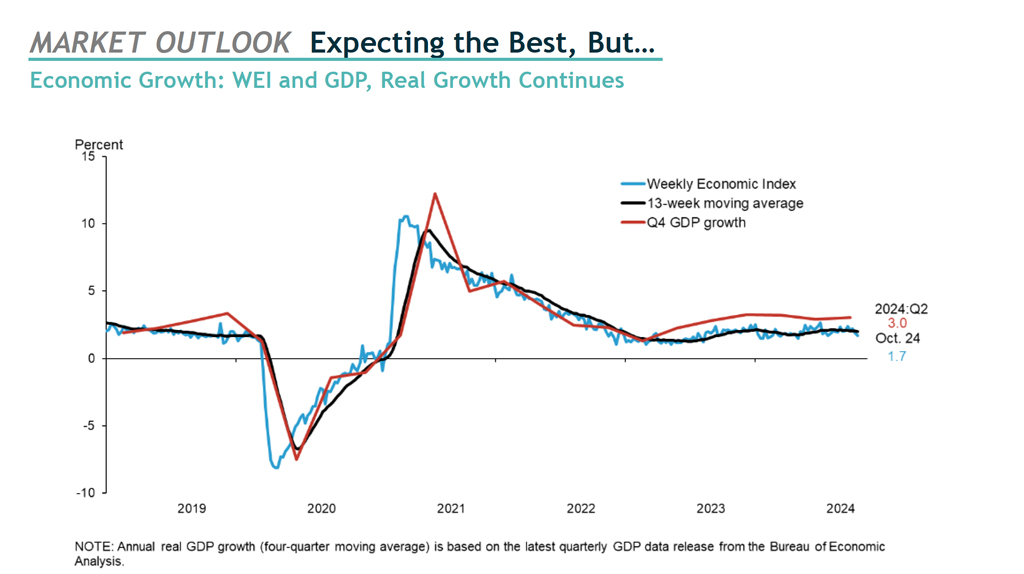
It’s also interesting to look at inflation in many of the major developed economies around the globe. Eric highlighted the below graphic for the first time showing how inflation in these major global economies was bouncing around a bit until the pandemic, and then tended to correlate. Within a year of the pandemic, we see that a couple of major things happened.
One is that all the major central banks followed the lead of the Federal Reserve. The recession only lasted about 3 months in the US from the pandemic because of all the fiscal and monetary stimulus that the government threw at it. Yet the Federal Reserve continued to keep interest rates at essentially zero and all the other central banks followed suit. This became a problem and we saw a knock-on effect as inflation was ignited all over the globe.
What we see now that all these central banks are catching up to the Fed in lowering rates is that inflation is falling. Eric predicts that we’ll continue to see inflation fall and hopefully won’t join the UK where the rate of inflation is too low because deflation can be a real problem.

In conclusion, Eric left clients with some final thoughts. Unlike past years, this year we’re more worried about politics and global conflict than the economy. We’re optimistic about the stock market, but we’re able to enjoy higher returns on safer investments than has been the case in decades, so you don’t have to take risk you don’t need.
The U.S. Presidential Election Has the World on Edge. American election integrity is critical to our democracy and economic prosperity, and we are all waiting to see if the election results, regardless of the outcome, are accepted by the citizenry as legitimate. Policy choices that include taxation, immigration, and civil rights, continue to divide the country. In other words, there will be a lot of unhappy voters no matter what the result. However, historical data suggests that markets have gone up over long periods of time under every administration, regardless of party. American ingenuity and our capitalist system have combined to drive the economy, and our capital markets, forward under almost all political circumstances.
BIP Wealth Has New Tools in the “Toolbox.” Each investment tool, or strategy, is a potential component of a comprehensive investment plan. Each tool has a distinct role to play in an overall investment strategy, and not every tool is needed by every investor. For instance, the BIP Concentrated Stock Strategy seeks to reduce the volatility of a single large stock holding by half, but many investors don’t hold such positions. The BIP Short-Term Tactical takes advantage of the current yield environment to pursue capital preservation while seeking yields meaningfully higher than what most banks are able to offer.
If you’d like to speak to an advisor about your portfolio or want to learn more about how we’re engineered to perform for our clients, be sure to contact us. You can also check out the rest of our resources hub to learn more about the financial market.
Eric has three responses to this:
Yes, that is just South Korea and the rules about listing countries follow a hierarchy. We have developed markets like our own and you have to have property rights and regulation and capitalism functioning more or less the way you’d want it to be with mostly free markets. Then you have a second tier that we call Emerging Markets where some of those things don’t work quite as well. South Korea is certainly a developed market, but then you get other economies that are capitalist and their markets you can invest in and and they’re called Emerging Markets. What we’re showing is the top level developed markets but then also the Emerging Markets, not the frontier and then not the uninvestable markets.
Current tariffs, originating from both the Trump and Biden administrations, can stifle economic growth by disrupting free market dynamics. While some manufacturing has shifted to the U.S. to avoid tariffs, other sectors like textiles have lost jobs overseas, leading to potential inflation and slower global growth. Regarding technology, at BIP Wealth, we advocate for a balanced investment strategy that includes both growth and value stocks, noting that many profitable companies aren’t strictly growth-focused. Additionally, technology’s influence permeates various industries, with advancements like AI benefiting even non-tech sectors. Overall, the relationship between tariffs, technology, and investment is complex and multifaceted.
This communication contains general investing information that is not suitable for everyone and is subject to change without notice. Past performance is no guarantee of future results and there is no guarantee that any views and opinions expressed will come to pass. The information contained herein should not be construed as personalized investment advice, tax advice, or financial planning advice, and should not be considered a solicitation to buy or sell any security. Investing in the stock market and the bond market involves gains and losses and may not be suitable for all investors. Indices are not available for direct investment.
Author: Eric Cramer, CFP® CFA®
September’s strong jobs report surprised some, but we’ve been telling our clients the economy is fundamentally strong all year. The short version of what we learned with the release of the September jobs report is this: We added 254,000 jobs in September, which is much stronger than the 150,000 consensus forecast.
What does this mean for the economy?
It was widely reported in late August that the BLS had a massive revision downwards in job growth from 3/2023 to 3/2024 (they revise every year). They reduced the amount of job growth by 818,000 jobs, which is one of the largest downward revisions ever. This stoked concerns of a “jobs recession” even though employers are struggling to find workers and other data (such as job openings) confirm a generally strong labor market.
It was less widely reported that in September, real GDP through the end of 2023 was revised up by 1.2%, and 2024 Q2 was revised up .1%. This was mostly due to stronger consumer spending, a metric we have consistently tracked (while also debunking the notion that consumers had run out of money).
It looks like the Fed’s slow pace of lowering rates hasn’t pushed us into a recession. And the Weekly Economic Index (WEI predicts GDP) suggests we aren’t headed for a recession anytime soon.
What does this mean for interest rates?
The strong economy may mean the Fed will take its time lowering interest rates. Current futures pricing shows a 25 bps cut on 11/7 and another 25 bps cut 12/18. Inflation is generally under control, but if energy prices spike due to increased tensions in the Middle East this could affect the data. But it’s safe to expect that we can continue to earn a yield on the short end of the Treasury yield curve that is well above the rate of inflation, and that our Short-Term Tactical strategy will have a useful role to play in client portfolios for the foreseeable future.
At the same time, longer term yields are on the move upwards. If this continues, then we will eventually end up with a so-called “normal” yield curve where investors earn more than the rate of inflation across all terms (even though we haven’t seen much of this for decades). This would be great for investors and businesses, and is what we can expect if the Fed eventually gets to a neutral stance and lets markets be free. It wouldn’t be unreasonable to expect that by the end of 2025 we have the short end of the curve at about 3-3.5%, with the long end of the curve at 4-6%. But there is a lot going on in the world right now that could change the picture between now and then.
What does this mean for the stock market?
As we’ve been saying all year, a strong economy that doesn’t go into a recession suggests it’s a good time to be a stock market investor. A Fed that is lowering rates, and promises to lower them as much as needed to protect the economy, is called the “Fed Put.” We’ve got that right now, and that’s about all a stock market investor could hope for.
But that doesn’t mean there won’t be some companies that aren’t big losers. Individual stock volatility is still quite high, and we think that will continue. Macro events, along with changes in technology that include the emergence of AI as an essential business tool, will re-order the competitive landscape. Many billions of dollars are being invested in innovation all over the world, and especially in the U.S. This isn’t happening in a vacuum—it’s happening with the explicit intention of changing which companies win, and which fall by the wayside. That makes it a good time to be diversified, and for many investors a good time to look at investment strategies like our Concentrated Stock strategy to manage risk.
Welcome to another BIP Wealth Quarterly Market Report with Eric Cramer, CFP®, CFA®, Chief Investment Officer. In his Q3 2024 report, Eric walked us through his economic summary from the past few months, including a timeline of major events and the performance of the U.S. Stock Market.
In case you missed the presentation, we’ll go over the main talking points below. You can also watch the recording of Eric’s presentation below.
When you look back on the key events that happened in Q2, you’ll notice that the markets remained very calm throughout much of the process. Two major headlines stood out when analyzing the market’s overall performance. The first was Japan intervening against the Yen as it slid relative to the U.S. Dollar. However, this was not “new” news to those in the financial world. We knew this was coming and had a solid plan in place to tackle the market volatility that followed.
The second major headline centered around U.S. hiring rates slowing, boosting hopes of a late-summer rate cut. This was another development we saw coming, as the labor market was overdue for a dip. This is all to say, don’t follow the doomsday headlines too closely. So long as you have a versatile financial plan in place, there are ways to navigate market volatility.
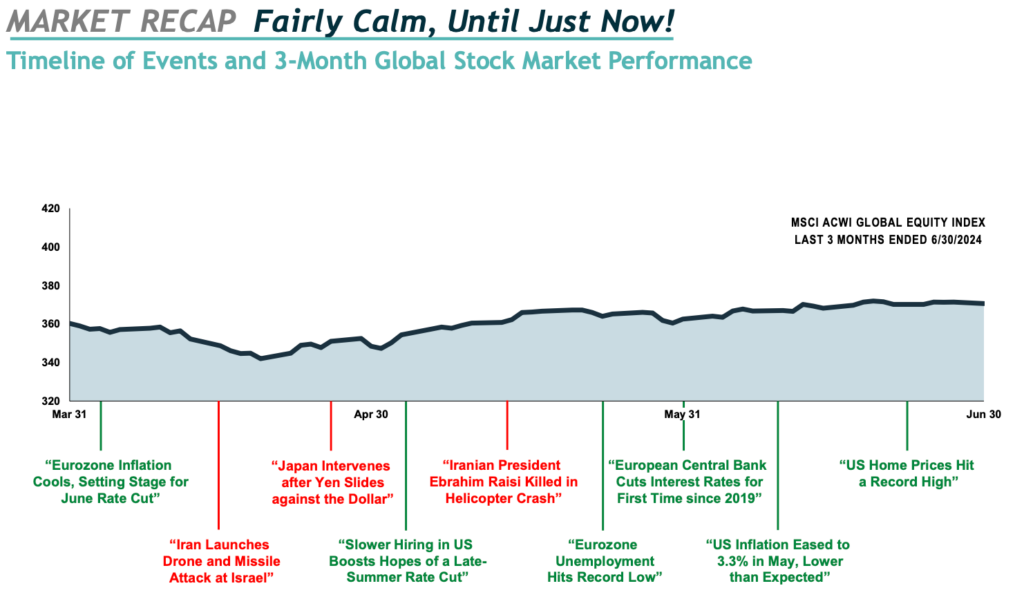
Looking at our blended benchmark results, the Q2 numbers don’t tell the whole story. While the fixed income index is negative, our clients have done substantially better since we don’t take the same risks. Additionally, the global equity index’s YTD performance sits at 10.28%. So, if you thought these numbers were pretty good for being halfway through 2024, they’re even better now as we plow our way through Q3.
The first thing to look at when discussing Fed “Put” vs. volatility is what we call “Medium-Term Forecasts”. In the report, Eric highlighted the projected 2025 numbers for the most important economic issues, such as real GDP growth (over the rate of inflation) and the unemployment rate. What the numbers show is that nobody is truly predicting an economic recession, even though you may continue to see this in the news headlines.
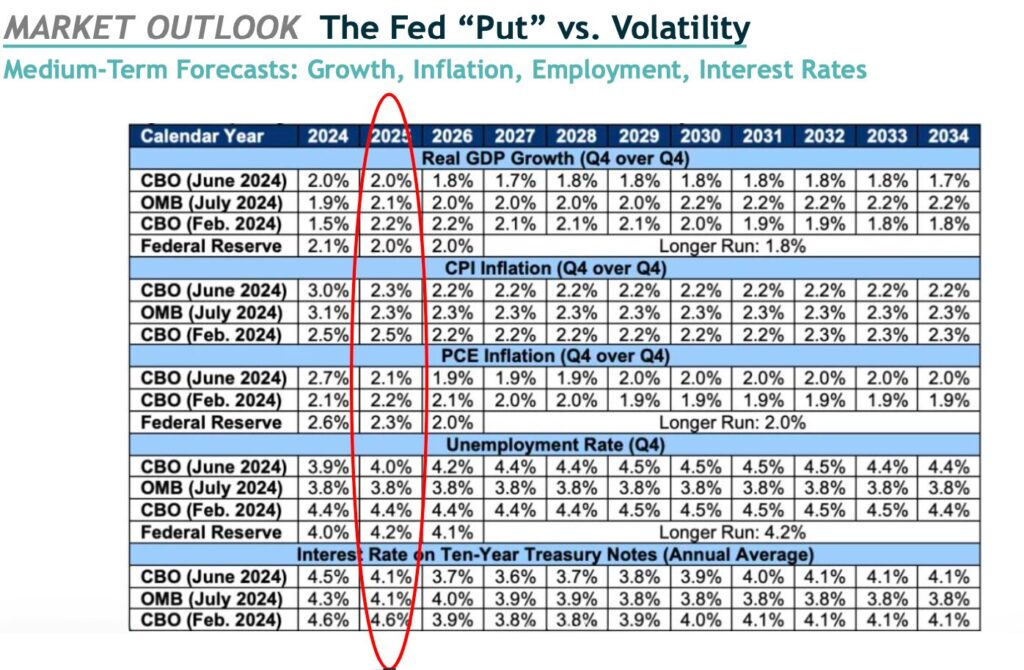
It’s also important to look at inflation in U.S. housing. While many of us have become addicted to reading the latest numbers, Eric discussed why the Consumer Price Index (CPI) rate, as shown in the graph below, is not the best indicator of inflation. This is due, in part, to 66% of American households owning their own home instead of renting. When the value of homes goes up, they are not affected like renters are. As a result, we should not be surprised to see negative CPI numbers in the near future.
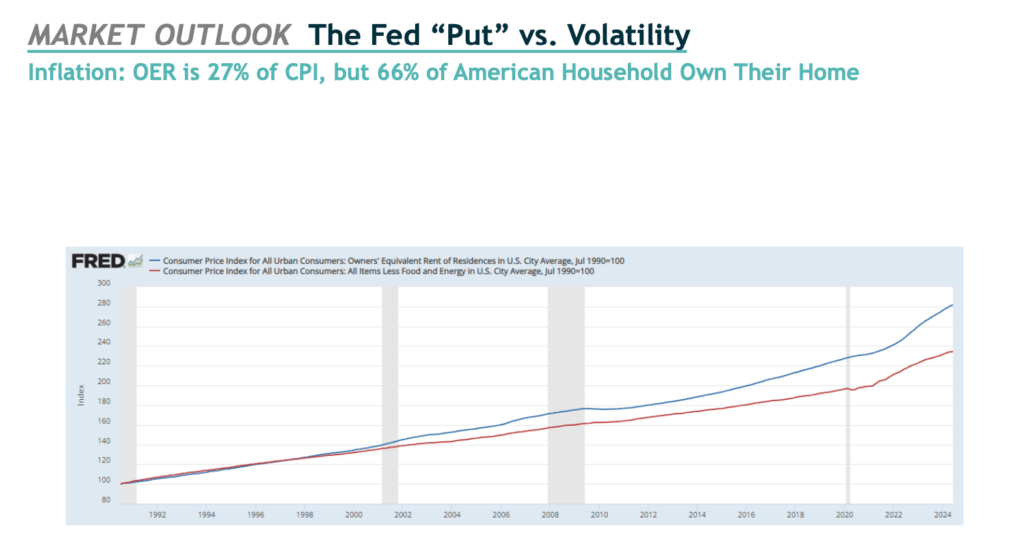
Additionally, the significance of working from home could impact the job market, as it may allow more to participate. Despite what you may hear, we currently have an abundance of open job positions waiting to be filled. And the data shows that companies are offering work-from-home benefits that are very similar to what the current workforce desires. The chart below highlights these numbers further.

Before signing off, Eric left our clients with his three biggest talking points for Q3. The first is that our economy is fundamentally strong. Every broad measure of our economy is healthy at the moment, although there are specific issues such as inflation in housing that are affecting some. The second is that we will survive the upcoming election in Q4. It’s easy for certain individuals such as economic analysts to mislead their audience with a political agenda. Remember that if you’re only looking at one news source, you’re only getting one side of the story. Always be on the lookout for the truth. Finally, BIP continues to add new tools to the toolbox. The BIP Short-Term Tactical, for example, takes advantage of the current yield environment to pursue capital preservation while seeking yields meaningfully higher than what most banks can offer.
If you’d like to speak to an advisor about your portfolio or want to learn more about how we’re engineered to perform for our clients, be sure to contact us. You can also check out the rest of our resources hub to learn more about the financial market.
BIP Wealth invests in private equity differently than the industry. We have direct access to private market opportunities through our venture capital firm, BIP Capital. We have a rigorous investment committee process where we vet various private equity opportunities, that are in it for consistency. We have a different approach from standard private equity investing and use financial planning software to perform a thorough analysis of each client’s financial situation, so we’re not taking uncompensated risks.
BIP Wealth has models in our financial planning process that can provide baseline recommendations of allocations for private equity investments. However, it all depends on your personal circumstances. We make adjustments for different factors including life expectancy, liquidity needs, and your understanding of the market and how it works.
This communication contains general investing information that is not suitable for everyone and is subject to change without notice. Past performance is no guarantee of future results and there is no guarantee that any views and opinions expressed will come to pass. The information contained herein should not be construed as personalized investment advice, tax advice, or financial planning advice, and should not be considered a solicitation to buy or sell any security. Investing in the stock market and the bond market involves gains and losses and may not be suitable for all investors. Indices are not available for direct investment.
Author: Eric Cramer, CFP®, CFA®
We’ve seen stock market volatility lately after an extended period of unprecedented calm.
What could cause the markets to erupt like this? Don’t believe the headlines that it was a slower employment report, or even that it was the Japanese “carry trade.” We need a softer job market to relieve some of the pressure employers face when looking for new hires. We’ve known the carry trade (borrowing cheaply from Japan and investing at a higher rate in the U.S. and elsewhere) was ending. The financial media writes these headlines because the human brain needs a “story” to process information, but those headlines aren’t necessarily the most impactful headlines or why we’re seeing such stock market volatility.
We estimate that approximately 70% of all stock market trading volume comes from split-second algorithmic trading. It’s driven by computer programs, and it happens so fast that the role of humans is only to design the trading algorithms (even that is moving to AI) and to oversee things in case the actions of the algorithms get too extreme, and someone has to pull the plug. The regulators have put so-called “stock market circuit breakers” in place to pause, or even shut down, the stock market out of fear that the algorithms can’t be stopped. Many of the algorithms read headlines, look at short-term trends (think of a few seconds as short-term), and then place trades in microseconds. Every once in a while all the algorithms gang up on the market and accelerate the pace of the ups and downs causing stock market volatility.
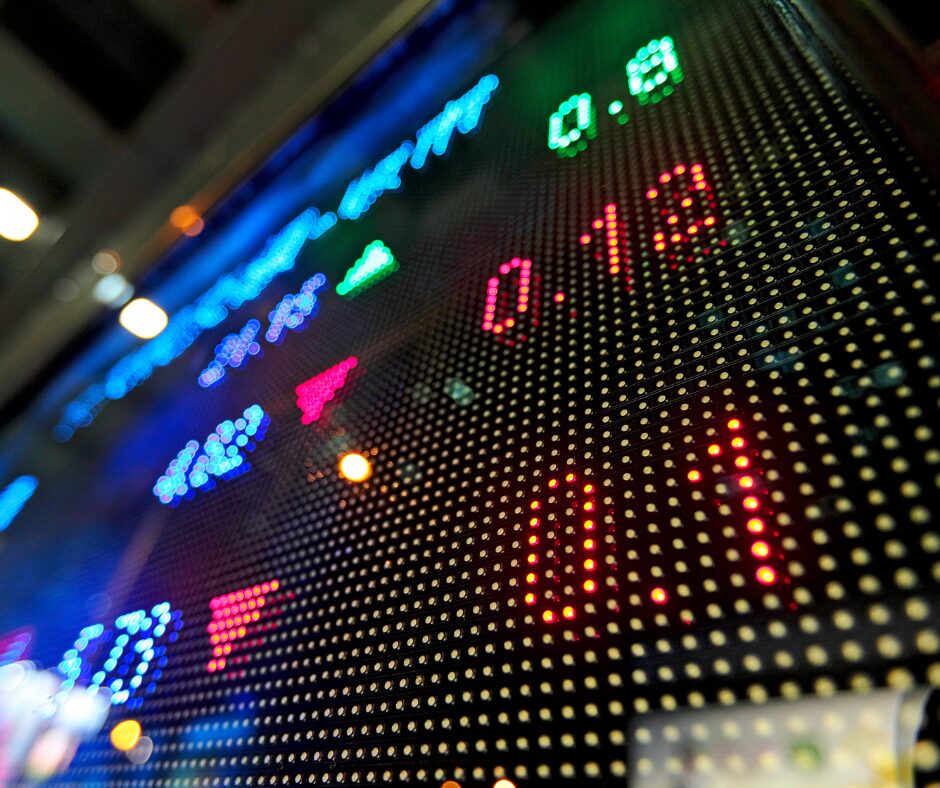
After months of abnormally calm markets, the most relevant headlines might actually be about how some of the high-flying technology stocks are not hitting their revenue/income expectations. Much of the run-up in tech stocks was probably driven by algorithms, but after a pretty big sell-off, value stocks are stealing the show. Value stocks have a long-term history of outperforming growth stocks, but the day-to-day flips between the two sides of the market are impossible to predict.
It is said in some circles that the Federal Reserve isn’t concerned about the markets and is instead focused on the economy, but this just isn’t true. Ever since the Tech bubble was growing uncomfortably large in the late 1990s (feel familiar?) the Fed has cared a LOT about the value of your portfolio. Ideally, some would say, the Fed would let excessive risk-taking by investors get punished. Healthy markets count on the Fed letting risk and reward be properly priced.
But just as some banks are “too big to fail,” Americans’ portfolios are too big a part of the economic health of the country to let them fail. What the Fed knows is this: if you rescue investors’ portfolios they will spend more, start more businesses, and relieve the government from spending on the social safety net. It is the ultimate “trickle-down” approach to economics and has become unwritten doctrine. The half of the U.S. population without any exposure to the stock market may suffer from the Fed’s actions in the form of inflationary swings, but the investor class gets to benefit from these policies.
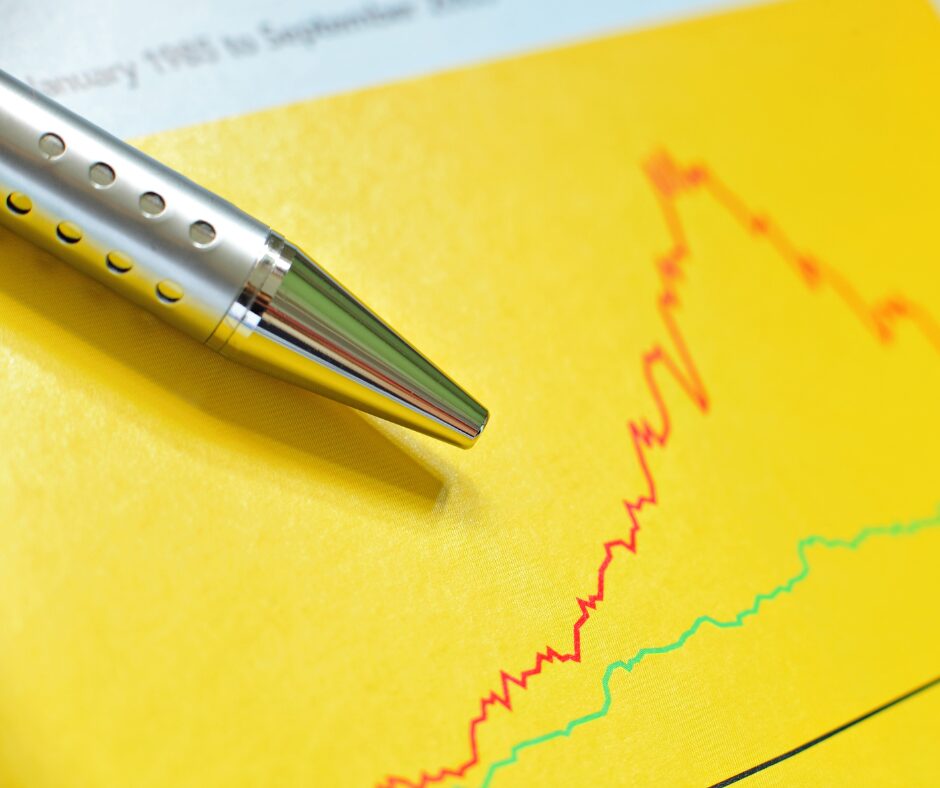
The only time the Fed backs away from this approach is when inflation is way too high, which it was over the past couple of years (but isn’t anymore). The Fed went too far in stimulating the economy after the pandemic. And then it was too late raising rates and is now too late in lowering rates. The Fed has been too extreme and too late in every rate decision it has made for twenty-five years, but it has helped investors and it’s going to rescue us again. With rates as high as they are now the Fed once again owns something called the “Fed Put,” which is nothing more than the ability to dramatically lower short-term interest rates to make all risky assets worth more. This will likely start in September, if not sooner, and may even go too far.
Inflation is over; it’s yesterday’s news; it’s a distant memory. The headlines aren’t telling you this yet, but we’ve been saying it all year. This will leave the Fed free to cut rates just as soon as it shows up in the latest economic data.
Here are a few key pieces of evidence for you:
When we manage the BIP Hedged Equity, BIP Hedged Yield, and BIP Concentrated Stock strategies, we use some math to adjust our options strategies, which are the backbone of our approach. That includes referencing the price of expected volatility in the markets (the “VIX”), which recently quadrupled in one week. This means we can generate a LOT of income selling options; we think this is good for our clients. In other words, these strategies were designed for stock market volatility.
But even our primary portfolios can do better in volatile times. If the remainder of this year is volatile, it might just give us the chance to “buy low and sell high” a few times in our clients’ portfolios. Rebalancing is often discussed as a method of risk control, but it can also present opportunities to increase your return. The key principle at play is that it usually makes sense to let the markets “gap down” before buying, and “gap up” before selling.

OK, maybe you need some of your capital to avoid as much stock market volatility as possible. We do have something for you too! You might have used cash for this in the past, but our BIP Short-Term Tactical strategy relies on the extremely liquid Treasury market to offer both liquidity and yield for this part of your holdings. Bank accounts have FDIC limits that can expose savers to theoretically limitless risk for balances above those limits, so putting excess cash to work in the Treasury market where investments are backed by the full faith and credit of the U.S. government could be a smart way to enjoy healthy returns while reducing risk.
Managing that volatility so that it works for you is what having an optimal financial plan is all about. Your Personal Wealth Advisor has a full toolkit of strategies that can be customized for your situation. With all of our public market strategies built around the concept of volatility, just remember this phrase, “Volatility is Your Friend!”
We estimate that approximately 70% of all stock market trading volume comes from split-second algorithmic trading. Many of the algorithms read headlines, look at short-term trends, and then place trades in microseconds. Every once in a while all the algorithms gang up on the market and accelerate the pace of the ups and downs. After months of abnormally calm markets, the most relevant headlines might actually be about how some of the high-flying technology stocks are not hitting their revenue/income expectations. Much of the run-up in tech stocks was probably driven by algorithms, but after a pretty big sell-off, value stocks are stealing the show.
Market indexes gain and lose every day. The larger and more often these price swings happen, the more volatile the markets are said to be. The VIX measures expected volatility.
VIX is a ticker symbol for the Chicago Board Options Exchange’s CBOE Volatility Index, which measures the price of expected volatility in the stock market based on S&P 500 index options.
The “Fed Put” is the belief that the Fed will step in to dramatically lower short-term interest rates to make all risky assets worth more and buoy markets if the price of markets falls to a certain level.
This post is provided for informational purposes only. Specific investments may not be suitable for all investors and no offer or recommendation of any investment or investing strategy is intended. The opinions in this commentary are as of the posting date and are subject to change. Information has been obtained from third-party sources we consider reliable, but we do not guarantee the facts cited are accurate or complete. This material is not intended to be relied upon as a forecast or investment advice regarding a particular investment or the markets in general, nor is it intended to predict or depict the performance of any investment. We may execute transactions in securities that may not be consistent with what is mentioned here. Investors should consult their financial advisor on the strategy best for them. Past performance is no guarantee of future results. All investments involve risks including loss of principal.
Author: Eric Cramer, CFP®, CPA®
Welcome to our recap of the 2024 Q2 Market Report. Eric Cramer, Chief Investment Officer at BIP Wealth, walked our clients through the current state of the U.S. economy and laid out his key takeaways from the second quarter of 2024.
In case you missed the presentation, we’ll break down the major talking points below, including the strong fundamentals we’re seeing and artificial intelligence’s role in combating inflation. You can also watch the recorded version of Cramer’s Q2 QMR by clicking the link below.
Regardless of some of the headlines we’ve seen recently, the U.S. market saw one of its smoothest quarters ever in Q2, according to Cramer. While there were individual stocks that had a rough quarter, a diversified portfolio more than likely enjoyed a smooth, consistent ride upwards. This is highlighted by the U.S. stock market finishing the first quarter up a little over 10%. Now, why is this? For Cramer, it all boils down to the strong fundamentals we’re continuing to see in the U.S. economy.
Unsurprisingly, growth stock led the charge for Q2’s market growth. However, the big news for Cramer is the continued rise in the U.S.’s share of the global stock market. With a current share of $50.7 trillion, the U.S. now controls 63% of the World Market Capitalization. This represents a 4% increase from just one year ago.
Another strong indicator of our current market health is the rate of available workers to available jobs. In 2020, for example, we saw a dramatic loss of available jobs due to the pandemic. Today, however, the number of available workers is outpacing the number of available jobs, which is great news. For Cramer, it is the backbone of his belief that we are not close to a recession anytime soon.

You may not have heard too much about this one, but we’re seeing unemployment rates among the major demographic groups in the U.S. collectively fall. This is a trend you see during a strong economic surge, regardless of who may be in control in Washington. For Cramer, the differences in the unemployment rates are about as small as he’s ever seen them. So, the rising tides have lifted all boats, if Q2 had anything to say about it.
A common piece of data that economists will use to showcase the strength of the economy is GDP. For Cramer, though, the numbers in the Weekly Economic Index are just as important. What we’re seeing is that the WEI rate is settling into a 2% rate of growth. This is considered real growth, over and above the rate of inflation. This rate is very healthy, and it could even see an uptick in the near future.

Most of us experience inflation through commodities. You may go to the gas pump and have to pay more than you did the previous visit. You may find yourself seeing higher prices on groceries. Whatever your experience may be, many of us feel the volatility of commodities through these sorts of experiences. This does not paint the entire picture of inflation, however. There is also inflation with services. When we buy things today, we’re very likely to be paying for services as often as we are goods. The chart below demonstrates how as the prices for goods have fallen, the prices for services have gone up.

So, how might artificial intelligence play a role in this world of inflation? For Cramer, there are some similarities and lessons from the past to watch out for. According to a 2023 report from Goldman Sachs, it is estimated that AI could replace 300 million jobs while increasing the GDP by 7% over the next 10 years. As a result, we could see the prices for services decrease as AI’s role in industries such as healthcare, education, and others continues to grow. This is not to say we will need significantly fewer humans in the workforce, but similar to inventions like steam engines and the Internet, AI could help us grow markets through innovation and efficiency, which could lead to deflation.
Before signing off, Cramer left us with four key takeaways from the presentation. These ranged from the rise of AI to the overall themes of 2024:
When examining your financial plan with your BIP Wealth advisor, you may discuss the current political and geopolitical conflicts.
This is easy to miss in an election year. However, our team believes that every broad measure of our economy is healthy as it currently stands.
Don’t shy away from this, though. Instead, embrace what the future of artificial intelligence may hold for financial markets.
From opportunities in public and private markets to BIP’s hedged equity investments, our advisors are hard at work to ensure our clients maintain a diversified portfolio to combat volatility.
If you’d like to speak to an advisor about your portfolio or want to learn more about how we’re engineered to perform for our clients, be sure to contact us. You can also check out the rest of our resources hub to learn more about the financial market.
This communication contains general investing information that is not suitable for everyone and is subject to change without notice. Past performance is no guarantee of future results and there is no guarantee that any views and opinions expressed will come to pass. The information contained herein should not be construed as personalized investment advice, tax advice, or financial planning advice, and should not be considered a solicitation to buy or sell any security. Investing in the stock market and the bond market involves gains and losses and may not be suitable for all investors. Indices are not available for direct investment.
Author: Eric Cramer, CFP®, CFA®
If you’ve ever gone through the financial and investment planning process, you might remember that it took some effort. But you might look back at that investment in time and feel some sense of satisfaction that you did something for yourself and your family. Unfortunately, investment planning may be extremely dangerous to your financial health. Here are the top five reasons why:
How many working people can look back a decade and say that they would have accurately predicted their current income level? Fortunes change, people lose their jobs, people get promoted, and the future is unknown for most of us. Because of this, future earnings become one of the biggest financial planning mistakes people may make. If your financial plan assumes you have a healthy income for decades into the future, but that doesn’t happen, do you expect your retirement lifestyle to be the same? Anyone more than ten years from their planned retirement needs to understand why a certain income figure was used in their plan, and they might want to make their income estimates extremely conservative just to test for problems with their plan. A good advisor may even run more than one plan, using different income levels, to examine the sensitivity of the plan to this input. Another technique used for people approaching retirement is to assume that all income ends in the current year. This helps establish what your “worst-case scenario” may look like and every year of additional income just makes things better.
Life expectancy is a tricky thing for anyone to predict. The best investment planning probably assumes a very long life expectancy, because outliving your money is the biggest risk most people face. Avoiding “superannuation” is the main motivation for many people to engage in investment planning, which is why some planners may suggest using a life expectancy that you only have a 10% chance of achieving. This doesn’t mean that this estimate is more accurate, it simply provides a more prudent way to think about how to plan.
If your investment planning doesn’t address the concept of investment expenses, then you may need to ask some questions. Another big financial planning mistake you can make is not taking into consideration what you’re paying in fees and even taxes on investments. For example, your stock broker may start to crank out financial plans that use index returns to predict portfolio returns. But the reality may be that your investment accounts become full of high-cost mutual funds, annuities, and other fee-laden investment products that may not be able to quickly adjust to market shifts. It isn’t unheard of for an investor to pay more than 2% in total investment expenses (and sometimes much higher) while relying on a financial plan that assumes there are zero investment expenses. For a $1 million portfolio, that’s $20K per year that doesn’t compound. If you don’t think investment expenses are a big deal then consider this: at the end of 2017, the average annual return of the MSCI ACWI IMI Global Equity Index for the prior ten years was only 4.97. And the Bloomberg-Barclays U.S. Aggregate Fixed Income Index return over that decade was only 4.01%. If your portfolio was paying an extra 2% in fees then, depending on your allocation, you may have barely kept half of your returns. At the end of the day, your investment expenses really do matter.
Taxes are boring, yes, so let us tease you with this idea: if you own an actively traded mutual fund, and it realizes short-term capital gains (from selling stock it owned less than a year), then the fund has to distribute those gains to you along with a tax on the investments. Your investment planning advisor may not see it coming, and there may be little you can do to stop it. To make matters worse, the distribution that hits your account will now be taxed at your highest marginal rate (because it’s a short-term gain). On top of this, distributed short-term capital gains cannot be offset with realized capital losses. So, if your super stock-picking mutual fund was up 20% in a big year, but sold most of its holdings to reposition, maybe you had 10% distributed to you at a tax cost of around 4-5%. Suddenly that terrific 20% turns into only 15%. The big pothole here is when a fund has a down year, but still sells some winners, and you pay investment taxes on a negative return! It’s happened before and it will surely happen again. Will you make this common financial planning mistake?
Some investors won’t need Social Security to have a terrific retirement, but for most of us, it will at least play an important role. And here’s the thing: Social Security has its risks. It’s not hard to be cynical about this program run by the Federal Government, but in the interest of giving respect where it’s due, the Trustees responsible for running this giant entitlement program write some of the best financial reports you will ever read. They have been telling us for years that there are major Social Security risks ahead, and it’s getting closer to reality. In the 2023 Annual Report, it was estimated that in all likelihood the program will exhaust itself by 2033. At that point, they estimate, benefits will have to be cut by 23% to match annual tax collections. We can’t know how our current and future politicians will address this problem, but if your investment planning isn’t assuming a cut to your currently legislated benefits, you may be counting on money that you will never receive.
At BIP Wealth, we focus on holistic wealth management to help our clients fortify long-term success and avoid the common financial planning mistakes you read about above. To learn more about our services, check out our What We Do page. If you’d like to get in touch with one of our wealth advisors, feel free to contact us!
How do I estimate future earnings?
Although it is very difficult to accurately predict your future earnings, it may be helpful to create more than one investment plan to determine what your financial situation could look like in different scenarios.
What is superannuation?
Superannuation refers to a retirement savings system in which individuals set aside a portion of their income during their working years to fund their retirement. It is commonly known as a pension or retirement fund.
What is an investment expense?
Investment expenses refer to the costs associated with managing and maintaining an investment portfolio. These could include advisor fees, taxes, and operating expenses.
When do you pay taxes on stocks?
Taxes on investments like stocks are typically realized when you sell them for a net gain or loss.
Is Social Security at risk?
In a recent estimation, it was said that Social Security could exhaust itself by 2033, resulting in a 23% benefits cut.
This communication contains general investing information that is not suitable for everyone and is subject to change without notice. Past performance is no guarantee of future results and there is no guarantee that any views and opinions expressed will come to pass. The information contained herein should not be construed as personalized investment advice, tax advice, or financial planning advice, and should not be considered a solicitation to buy or sell any security. Investing in the stock market and the bond market involves gains and losses and may not be suitable for all investors. Indices are not available for direct investment.